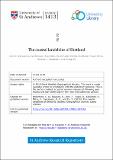Files in this item
The coastal landslides of Shetland
Item metadata
| dc.contributor.author | Ballantyne, Colin K. | |
| dc.contributor.author | Dawson, Sue | |
| dc.contributor.author | Dick, Ryan | |
| dc.contributor.author | Fabel, Derek | |
| dc.contributor.author | Kralikaite, Emilija | |
| dc.contributor.author | Milne, Fraser | |
| dc.contributor.author | Sandeman, Graeme F. | |
| dc.contributor.author | Xu, Sheng | |
| dc.date.accessioned | 2019-04-05T23:38:35Z | |
| dc.date.available | 2019-04-05T23:38:35Z | |
| dc.date.issued | 2018 | |
| dc.identifier | 252771972 | |
| dc.identifier | 7184cb16-a513-4bc4-8f90-36d51d38e85f | |
| dc.identifier | 85045075579 | |
| dc.identifier | 000433996600006 | |
| dc.identifier.citation | Ballantyne , C K , Dawson , S , Dick , R , Fabel , D , Kralikaite , E , Milne , F , Sandeman , G F & Xu , S 2018 , ' The coastal landslides of Shetland ' , Scottish Geographical Journal , vol. 134 , no. 1-2 , pp. 71–96 . https://doi.org/10.1080/14702541.2018.1457169 | en |
| dc.identifier.issn | 1470-2541 | |
| dc.identifier.other | RIS: urn:E6C400EA9AFCEFA6A55053329C935588 | |
| dc.identifier.uri | https://hdl.handle.net/10023/17471 | |
| dc.description | SD and FDM acknowledge support from NERC award NE/K000063/1 (‘Will climate change in the Arctic increase the landslide-tsunami risk to the UK?’). | en |
| dc.description.abstract | Little is known of hard-rock coastal landsliding in Scotland. We identify 128 individual coastal landslides or landslide complexes >50 m wide along the coasts of Shetland. Most are apparently translational slides characterized by headscarps, displaced blocks and/or debris runout, but 13 deep-seated failures with tension cracks up to 200 m inland from cliff crests were also identified. Thirty-one sites exhibit evidence of at least localized recent activity. Landslide distribution is primarily determined by the distribution of coastal cliffs >30 m high, and they are preferentially developed on metasedimentary rocks. Analysis of 16 landslides on Fetlar (NE Shetland) indicates that most are translational dip-slip failures; 3 represent deep-seated failures and several exhibit active frontal erosion attributable to basal sapping by storm waves. As these landslides terminate in shallow water, failure was probably initiated when rising sea level resulted in footslope erosion and upslope propagation of instability, causing downslope displacement of landslide blocks on upper slopes. 10Be exposure dating of two headscarps yielded ages of 4.8 ± 0.2 ka and 4.4 ± 0.2 ka, consistent with the onset of footslope erosion as sea level rose. Our results suggest that landslides have played a hitherto undocumented but important role in retreat of cliffed coastlines in Scotland. | |
| dc.format.extent | 26 | |
| dc.format.extent | 3090009 | |
| dc.language.iso | eng | |
| dc.relation.ispartof | Scottish Geographical Journal | en |
| dc.subject | Coastal landslides | en |
| dc.subject | Rock-slope failure | en |
| dc.subject | Sea-level rise | en |
| dc.subject | Arrested translational slides | en |
| dc.subject | Deep-seated failure | en |
| dc.subject | Cosmogenic 10Be exposure dating | en |
| dc.subject | G Geography (General) | en |
| dc.subject | GE Environmental Sciences | en |
| dc.subject | NDAS | en |
| dc.subject.lcc | G1 | en |
| dc.subject.lcc | GE | en |
| dc.title | The coastal landslides of Shetland | en |
| dc.type | Journal article | en |
| dc.contributor.institution | University of St Andrews. School of Geography & Sustainable Development | en |
| dc.identifier.doi | 10.1080/14702541.2018.1457169 | |
| dc.description.status | Peer reviewed | en |
| dc.date.embargoedUntil | 2019-04-06 |
This item appears in the following Collection(s)
Items in the St Andrews Research Repository are protected by copyright, with all rights reserved, unless otherwise indicated.

